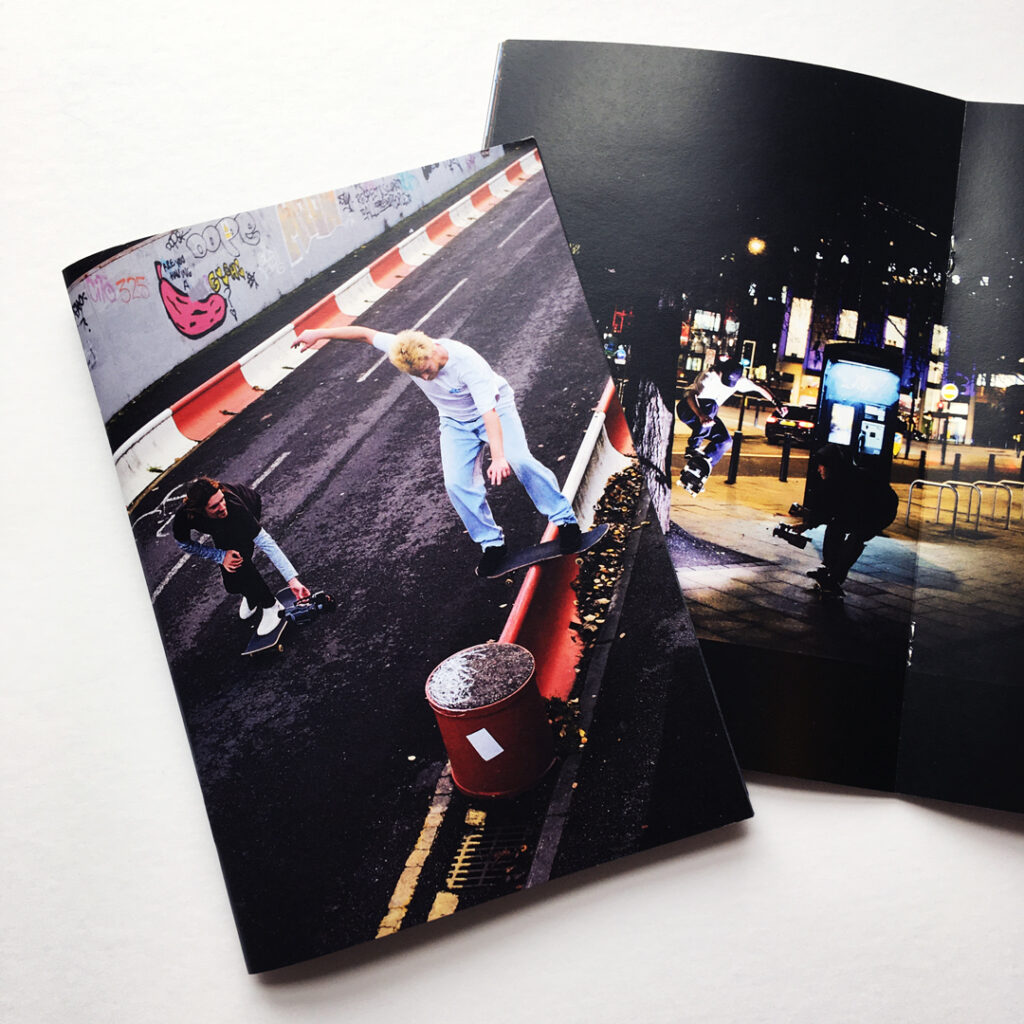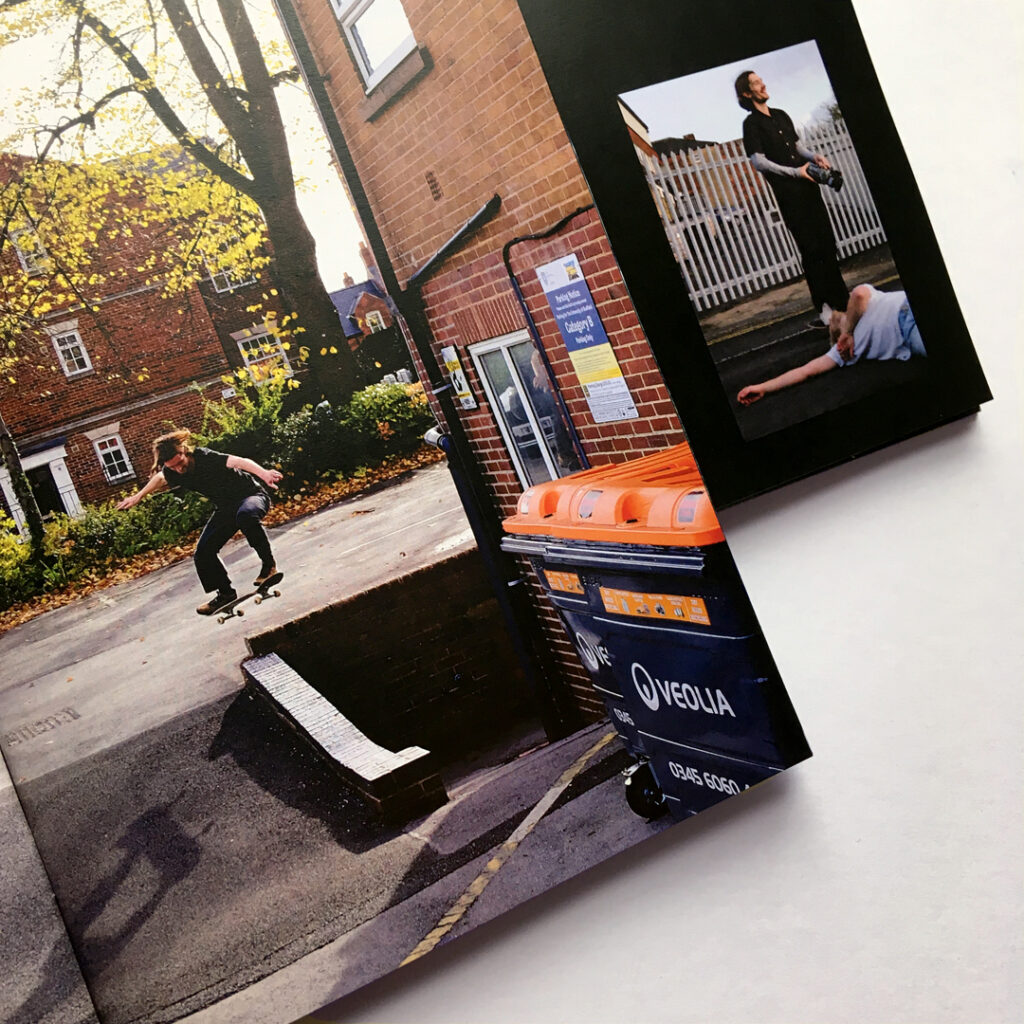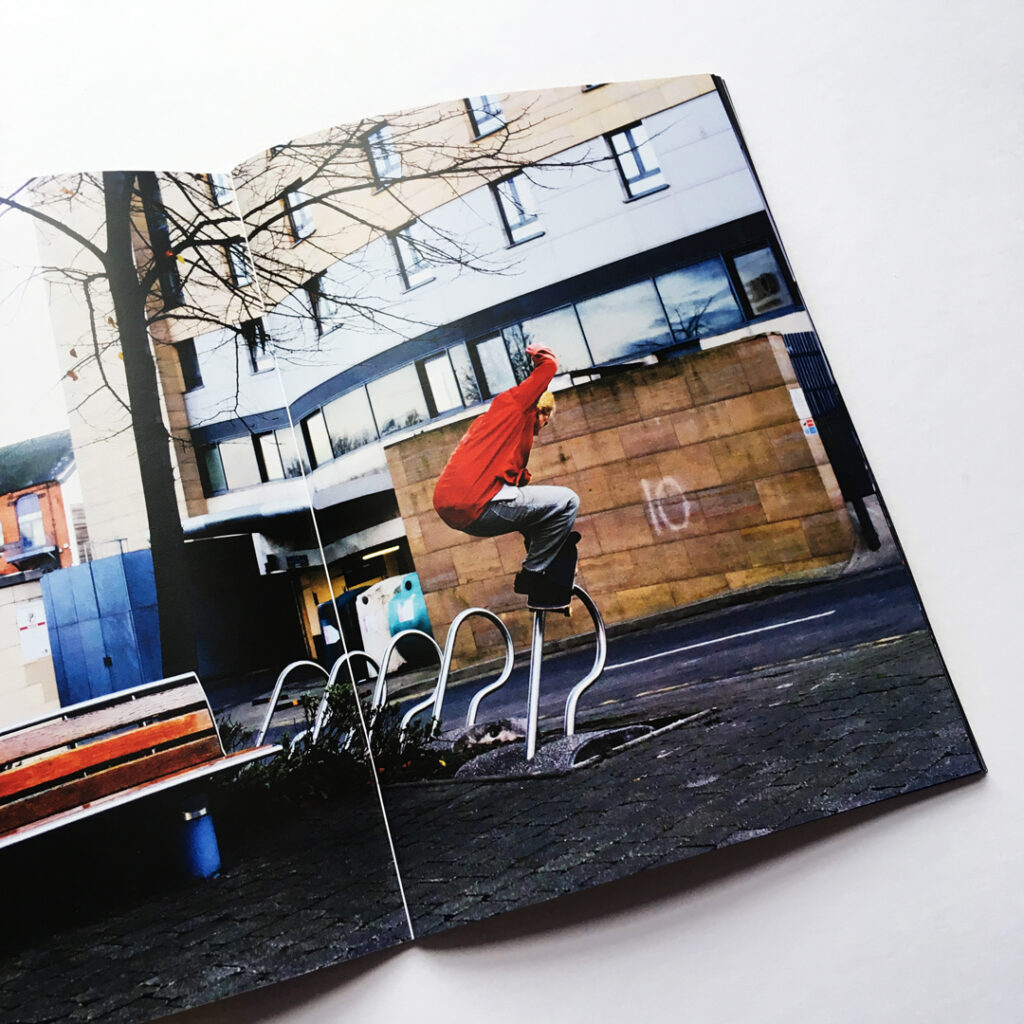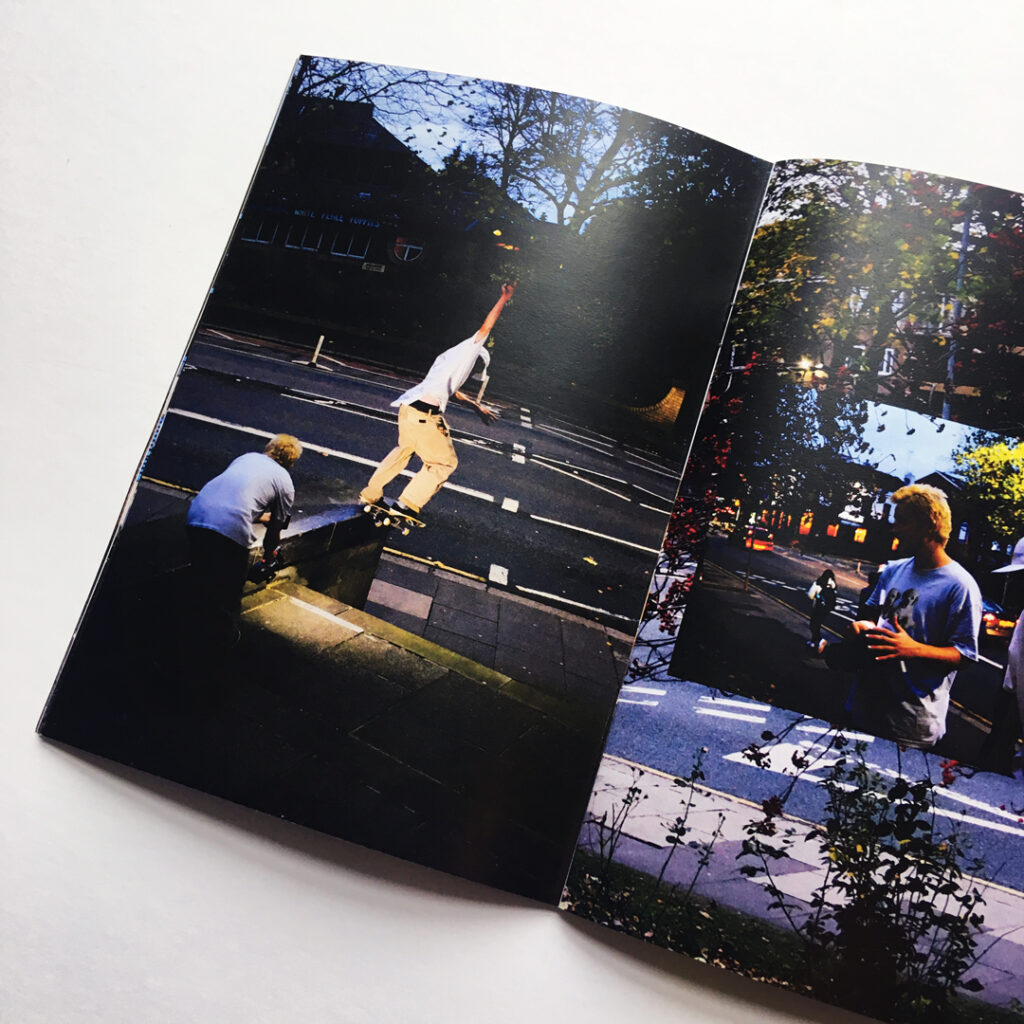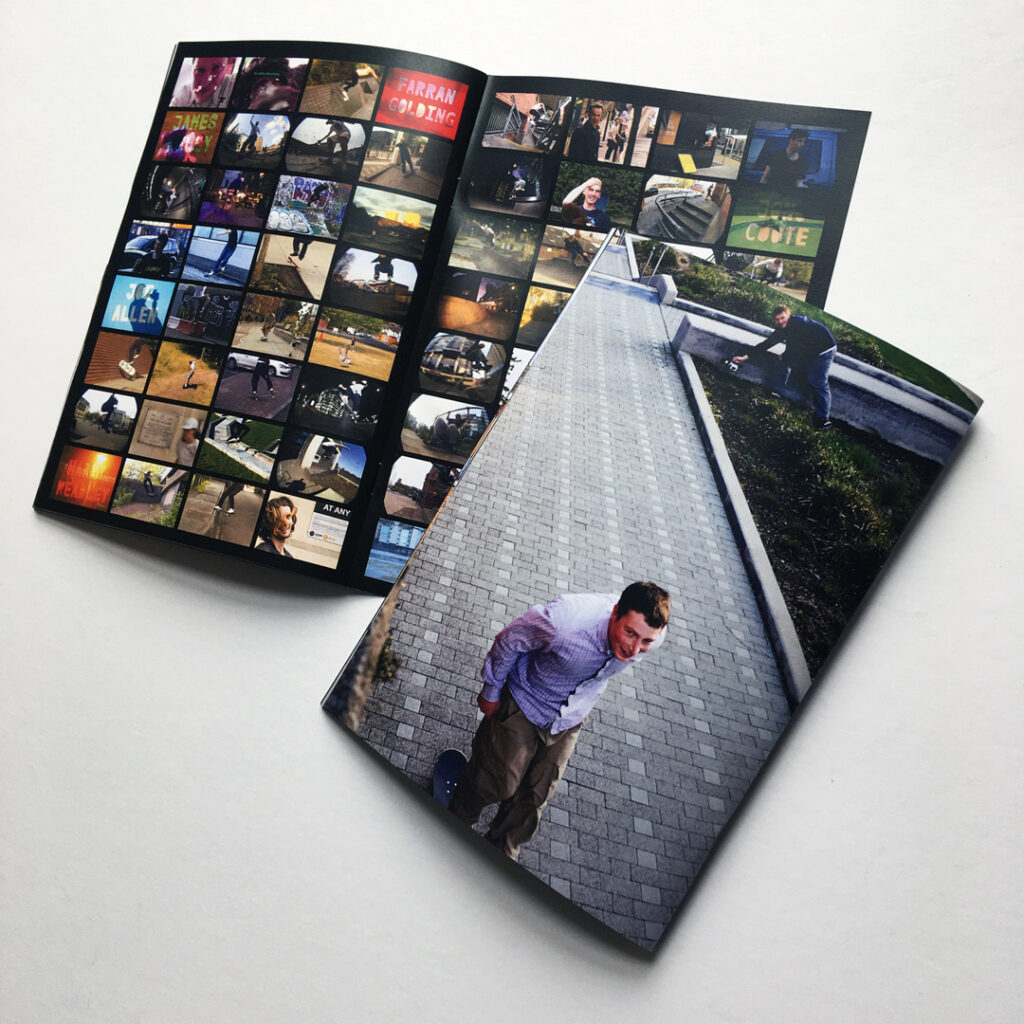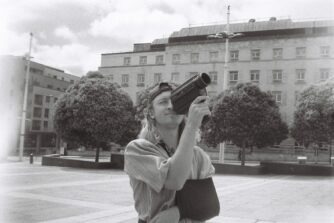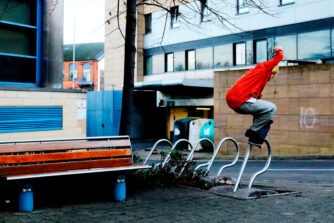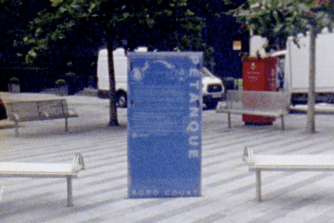The skate video output of Leeds has never fallen short, but recent years have seen an unprecedented uptake in local filmmaking. Joe Allen reignited the premiere circuit in fall 2021 with his full-length video PÉTANQUE and, not content with knocking out a part for his own project, he also filmed a section for Will Smith’s Assembly which hit the big screen shortly thereafter. Summer 2022 brought the highly anticipated second Welcome Skate Store video, WELCOME 2: HELL, with Josh Hallett and co.’s bar-setting efforts drawing new eyes to Leeds, from across the other side of the Pennines to the other side of the Atlantic. Upstart filmmaker Hilda Quick and her serialised “Drafts” series have brought another dimension to the city’s landscape, importing friends from Liverpool and Manchester who have made heavy additions to local spot folklore. Summer 2023’s premiere season was marked by Will Smith, now a cinematic workhorse, putting out videos in quick succession; MUSH, for Vans UK, and WEEDKILLER, featuring his broader crew.
Given this somewhat seamless chain of Leeds-based releases, it would be easy to assume they all came together without a hitch. That however is never the case for any skate video, local or of a larger scale, something I’ve witnessed Joe face first hand as he powered through his latest – undeterred by relentless technical issues. From broken cameras, to close friendships, to up-and-coming local kids, here’s what went into making his latest video, TROUBLESHOOTING.
Interview by: Farran Golding
Photography by: Farran Golding, Harry Medley, Al Lovell + Ruby Penson
Videography by: Joe Allen
Take me through your timeline of cameras for TROUBLESHOOTING.
I wasn’t filming a whole lot right after PÉTANQUE. Josh Hallett gave me his VX to finish up that video, and I’d got a few months into filming for this one by the time he needed it back. I got my VX “repaired” and it didn’t work, I took it out once and it was glitchy. I bought a new one, and I can’t remember at which point it started fucking up, but I had a capture camera for logging footage. In the midst of having no VX, or a “good VX”, I’d take that out to have a back-up. Then that thing died.
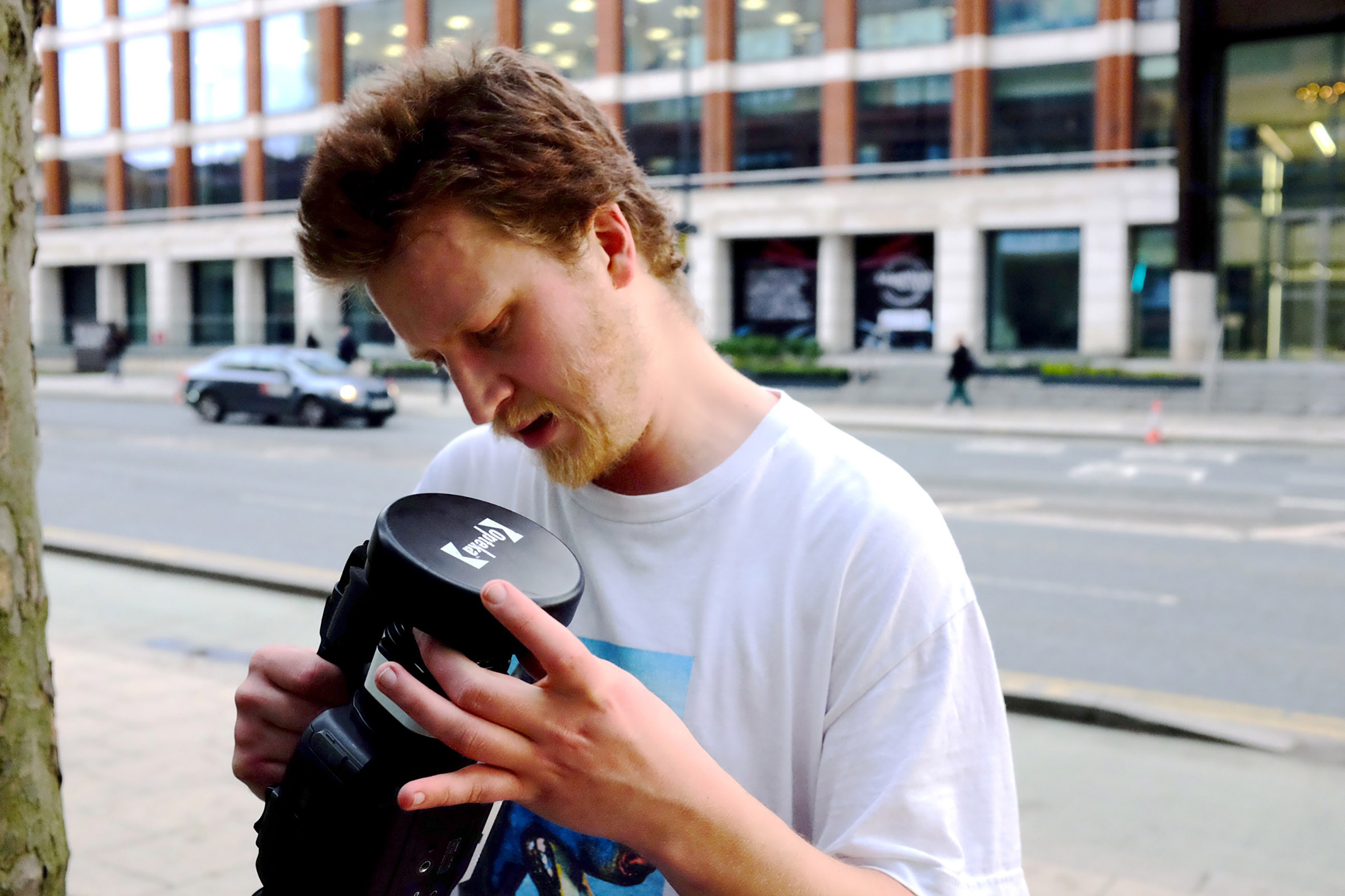
Joe Allen. photo: Farran Golding
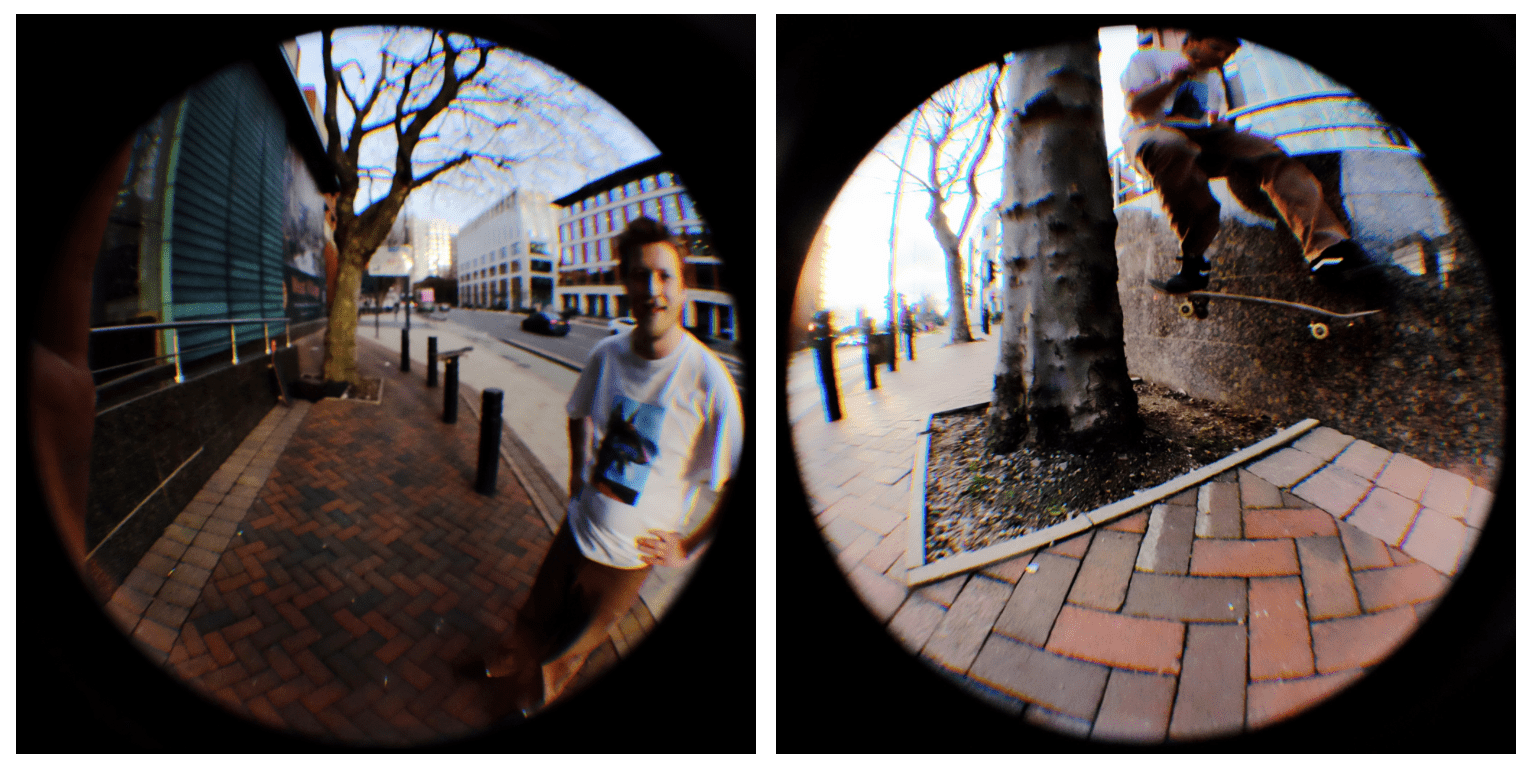
Joe Allen, thread the needle wallride nollie. photo: Farran Golding
Was that the point when you decided to learn how to fix a VX yourself?
Yeah. It’s such a blur because there were so many issues but, around summer 2022, the newer VX broke in a way that I was determined I could fix. My original VX, the tape heads were recording glitchy, but it did something correctly that the other didn’t so the first thing I managed to do successfully was swap around the tape mechanisms.
It was such a good feeling, I thought I was going to break both my cameras even more in the process of trying to fix them. I felt like a genius for a second. I wasn’t as successful as they kept breaking. I bought a Canon XM1 to wrap up but the deck made a grinding sound. Realising that’s what was ruining the audio, I bit the bullet and got a tapeless recorder. I wish I’d done that when I started having issues with the VX. If I did that the first time my tape deck broke, who knows if that first VX would still work. It’s hard to tell.
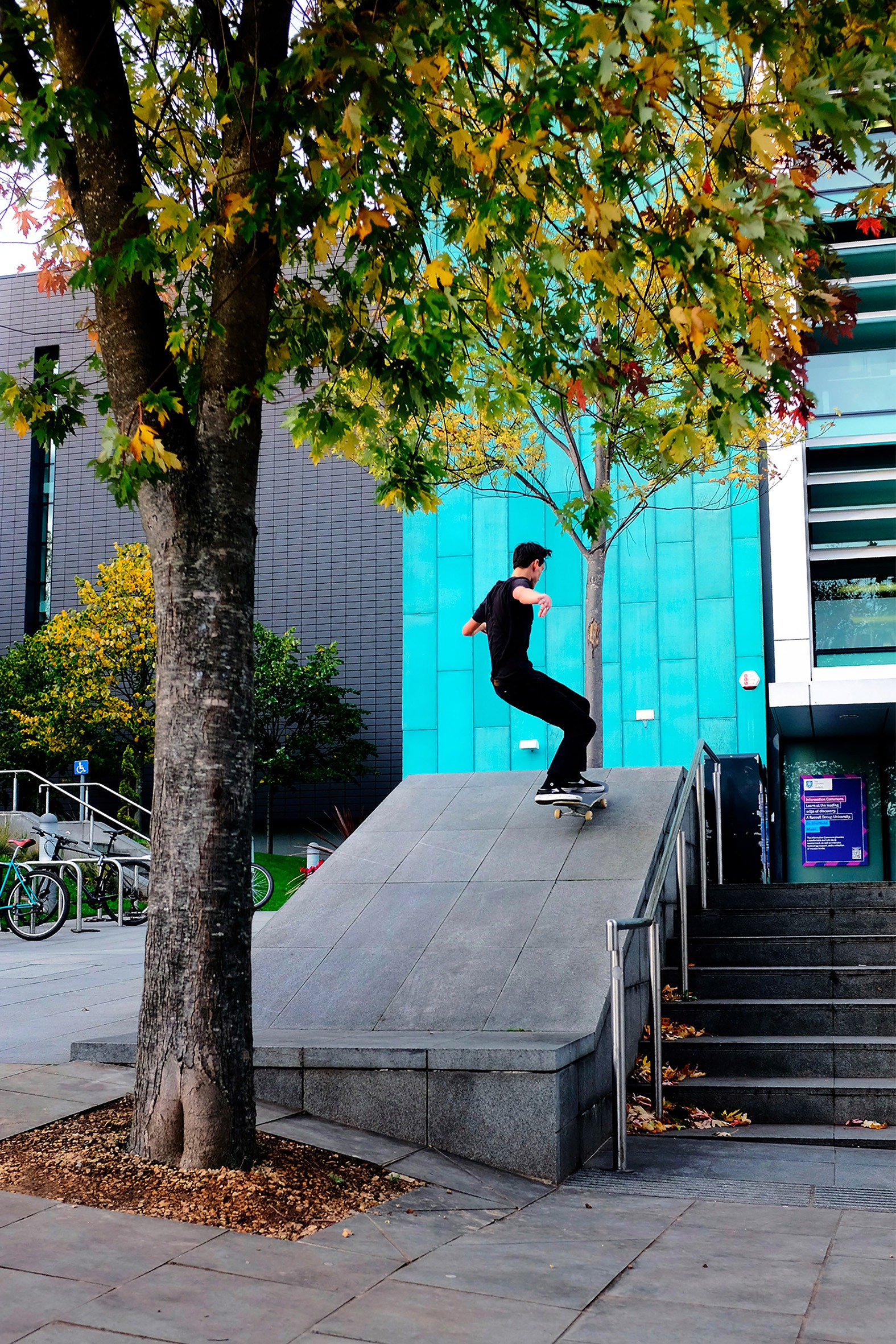
Farran Golding — nose manual up, Sheffield. photo: Harry Meadley
How did you land on TROUBLESHOOTING for the name after all that?
I didn’t have a video name until the last couple of months, whereas PÉTANQUE I had in mind for a long time and could work towards it. Me and Al [Lovell, Joe’s partner] were trying to think of names. I meant to say “brainstorming” – like, “let’s start brainstorming” – but I said “troubleshooting”.
It reminded me of Viewfinder and Headcleaner which are great video names and annoyingly already taken [laughs]. Harry Meadley felt it had a similar tone to Hating Life and those three videos also have ties to Leeds, fittingly. So, TROUBLESHOOTING. I had to fix cameras and was checking if they worked; if you split it into two words it’s like, “I was (having) trouble shooting (the video)”; and whilst filming I was working technical support over the phone so I was “troubleshooting” for a job.
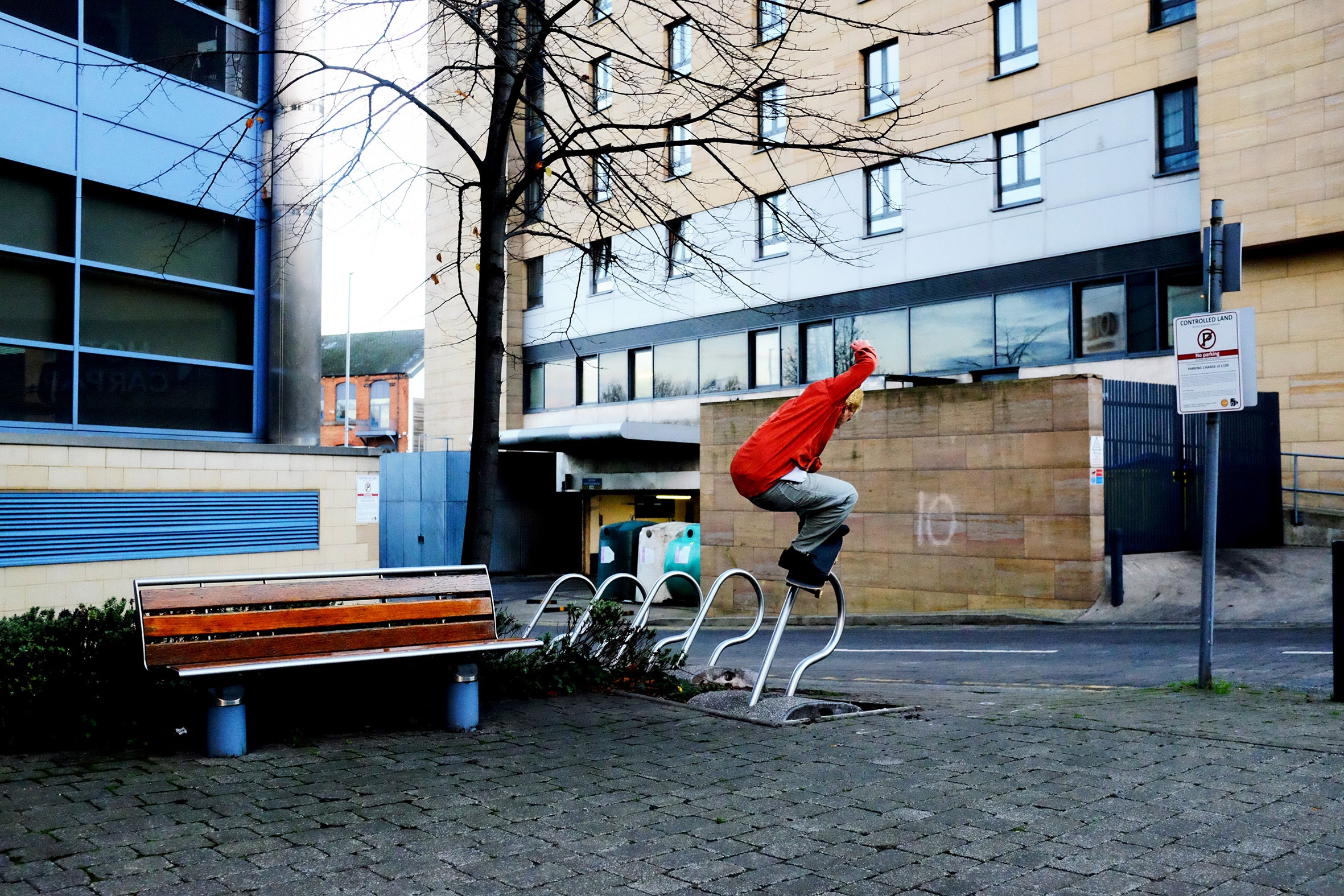
Joe Allen — pole jam, Leeds. photo: Farran Golding
I don’t think the VX will ever fade out completely but do you think its days are numbered in being accessible to the everyday filmer, like yourself?
Yeah, I don’t think it’s a feasible option anymore for people starting out. When I first started filming [summer 2017], I got a VX, a few tapes, a fisheye, batteries, and a camera bag for £400. Nowadays, pretty much any little thing relating to a VX costs £400 individually. If you have a working VX and a tapeless recorder, that’s probably the way forward. At the same time, it’s going to break and there are less people who fix them. I think it’s only going to be the select few who have put a lot of effort into filming VX – like Josh Stewart, Jacob Harris, or Beagle – where skaters want to see those individuals using it specifically, who can keep it going.
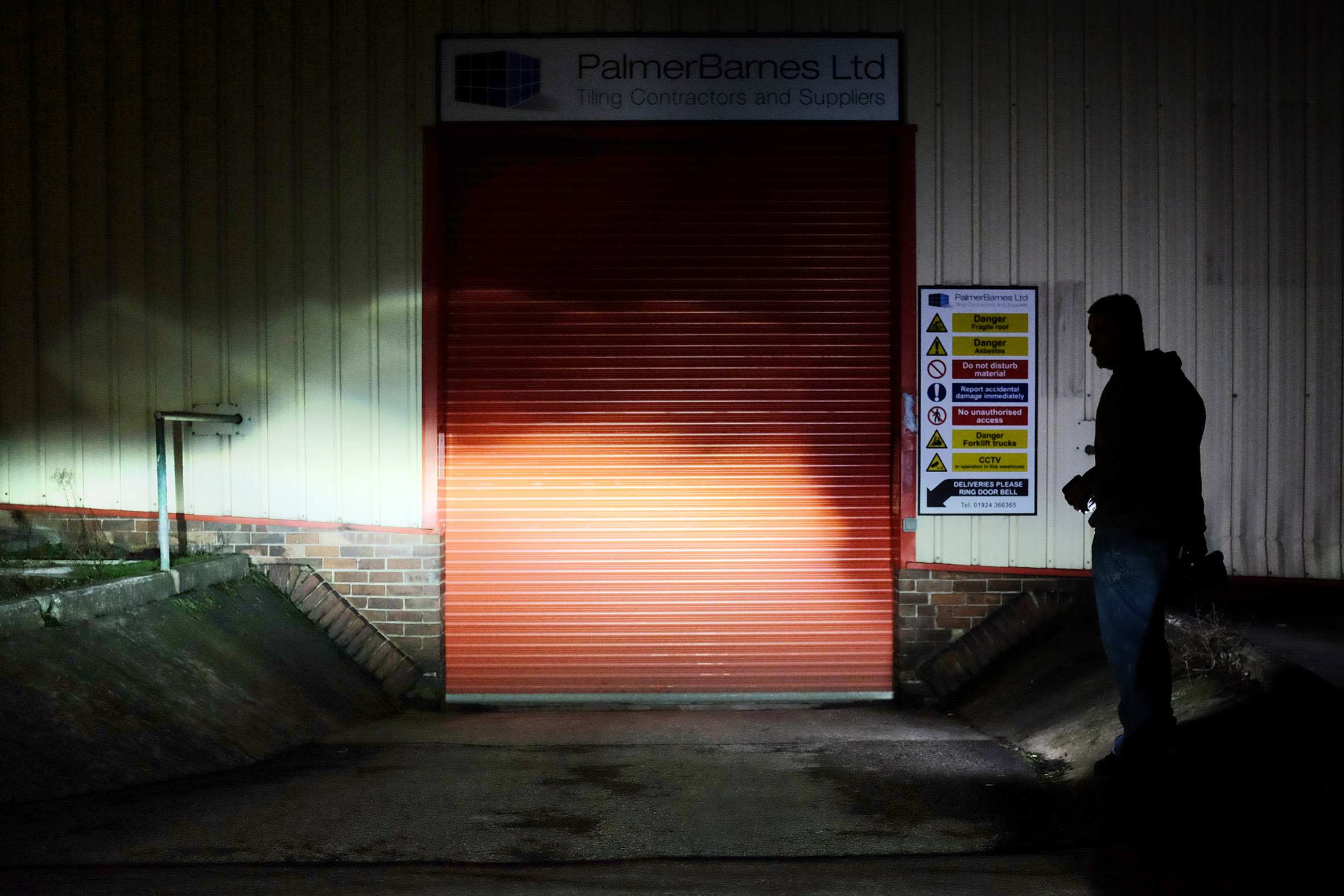
Joe Allen, Wakefield. photo: Farran Golding
What’s the VX’s main appeal for you? I’ve always got the impression you simply like the camera, rather than any nostalgic reason to keep running it.
I mean, it’s everything anyone has ever said before but VX videos, to me, feel like people are actively trying to film in a certain way that’s creative and different. Whereas over the last ten years with the popularity of certain HD cameras, apart from a select few videographers – and it’s mainly in the editing room they’re doing something unique, but HD filmmaking is roughly pretty similar. Not even, like, “post-Strobeck” or whatever but there’s less maneuverability to a heavy camera and massive fisheye, like the HPX, but a VX is compact and you can duck in and out quickly.
Nowadays, filmers know how to simulate that with other cameras. There are those who are diehard VX but there are HD 4:3 edits I enjoy just as much and it has that feel. It’s also how it feels going filming with it, you end up with a different type of video and the camera more suited to a local or smaller production. In the past ten years or so, probably off the back of Static, people have started filming with the VX in a certain way that’s now very attributed to it, like how Zach Chamberlain and Quentin Guthrie handle it, for example.

Tom Davies, Backside 50-50 Grind Shuv-it Out, Leeds. photo: Farran Golding
You’re rarely out skating without your camera in tow so is “going skating” and “going filming” inseparable at this point? Do you prefer to have a camera to hand even if filming isn’t feeling like a priority on a given day?
Pretty much. There are occasions where I just “go skating” but, for the most part, it’s either with my camera or a camera and someone else is filming like Will [Smith], Hilda [Quick], or Joe Winters as he’s started filming recently too. I guess there’s a fear of not having a camera and someone doing something crazy, especially with how many skaters there are in Leeds now.
There were days I’d intend to meet Naidan [Glover], Logan [Riley] or the younger kids and I’ve not ended up doing so for whatever reason. Then you see what they did that day on Instagram and it’s like, “Fuck, why didn’t I?”
At this point, I do cherish the days where I don’t take a camera out. It’s a nice break, a literal weight off my shoulders where I can just skate, which I feel like I don’t do a lot. But, if you’re busy filming a video you’ve got priorities.
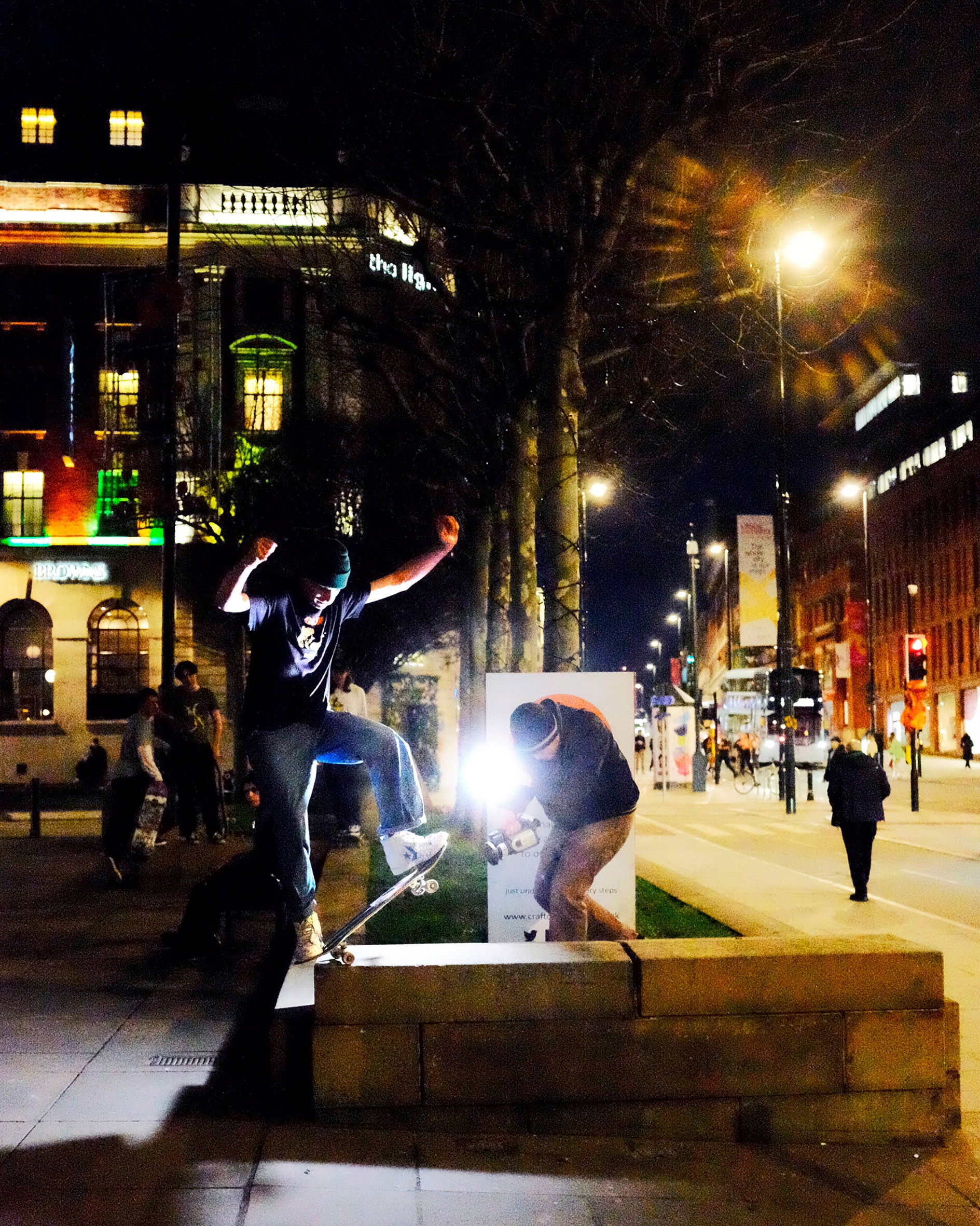
James Kelly – frontside nosebluntslide, Leeds. photo: Farran Golding
Hit the readers with a rundown of the main people featured in TROUBLESHOOTING, your relationship to them and what they’re like to film with?
I met James Kelly when he was at university and I’d skate with him, Luke Humphreys, Alex Petz and Alfie Warin. Those guys were “the crew” for a good few years. James has consistently either had a part or a good chunk of footage in everything since my second video, Buddy [2018]. He and Abi [Townsend-Smith, James’ partner], are always traveling or escaping to Barcelona for the winter. I set a soft deadline and he was away for a while leading up to it so he was a little worried about having enough footage but got more in the last stretch. He actually got his ender during the week before the premiere, it was the very last thing I filmed for TROUBLESHOOTING.
Beeston Banks is probably where Jono Coote and I clicked. Which is weird because I’m not a good transition skater but Beeston Banks didn’t feel like transition, in a way, but they weren’t banks either [laughs]. It was, however, in Beeston – I’ve said otherwise and since been corrected. He’s always down to skate in general but if we can skate something suited to Jono, often some form of street transition, then even more so.
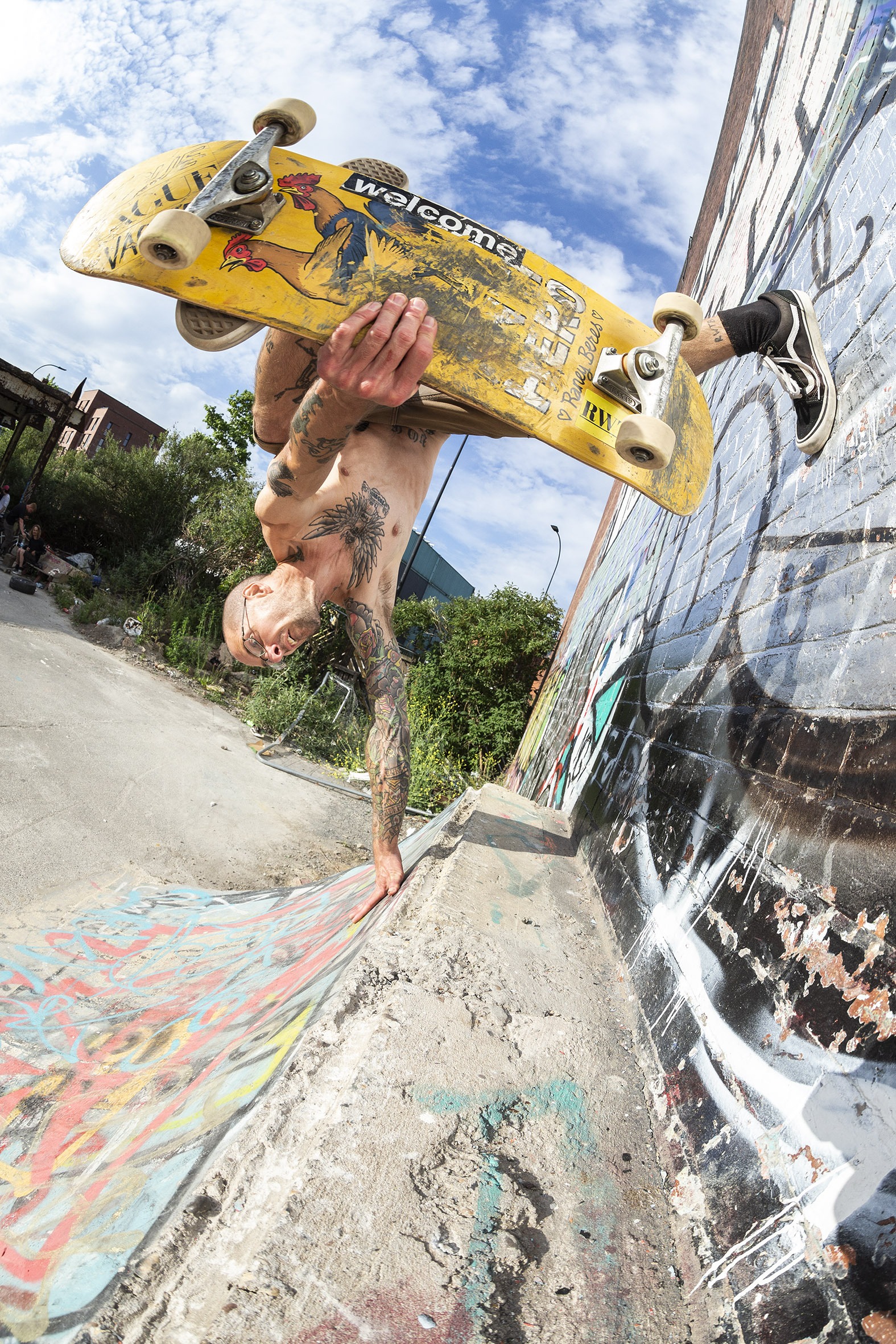
Jono Coote — invert wall plant, Sheffield. photo: Reece Leung
Tom Davies and Paul Watson are both people I hadn’t filmed with before. Wapo [Paul] has been slightly elusive for anyone to film with in the past but he’s pretty keen these days. Tom hasn’t been in Leeds for long but getting to know him, he’s the loveliest guy, super quiet, has a great style and lands things you shouldn’t be able to roll away from. It’s really perplexing. In a way, Paul’s like that as well.
Harry Meadley, everyone rates him highly. He had a little part in PÉTANQUE and then the most consistent crew for TROUBLESHOOTING has been Harry, you and I – often with Jono and James too – but the “base” crew has been us three. Harry’s so happy when he’s skating and he learns new tricks every time he goes skating. For the people who are progressing the most, it’s funny that it’s Logan and Naidan, then Harry who is literally double their age.
With you [Farran Golding], you’re always up for filming. I don’t even have to think about it, you’ve always got something that you want to do.
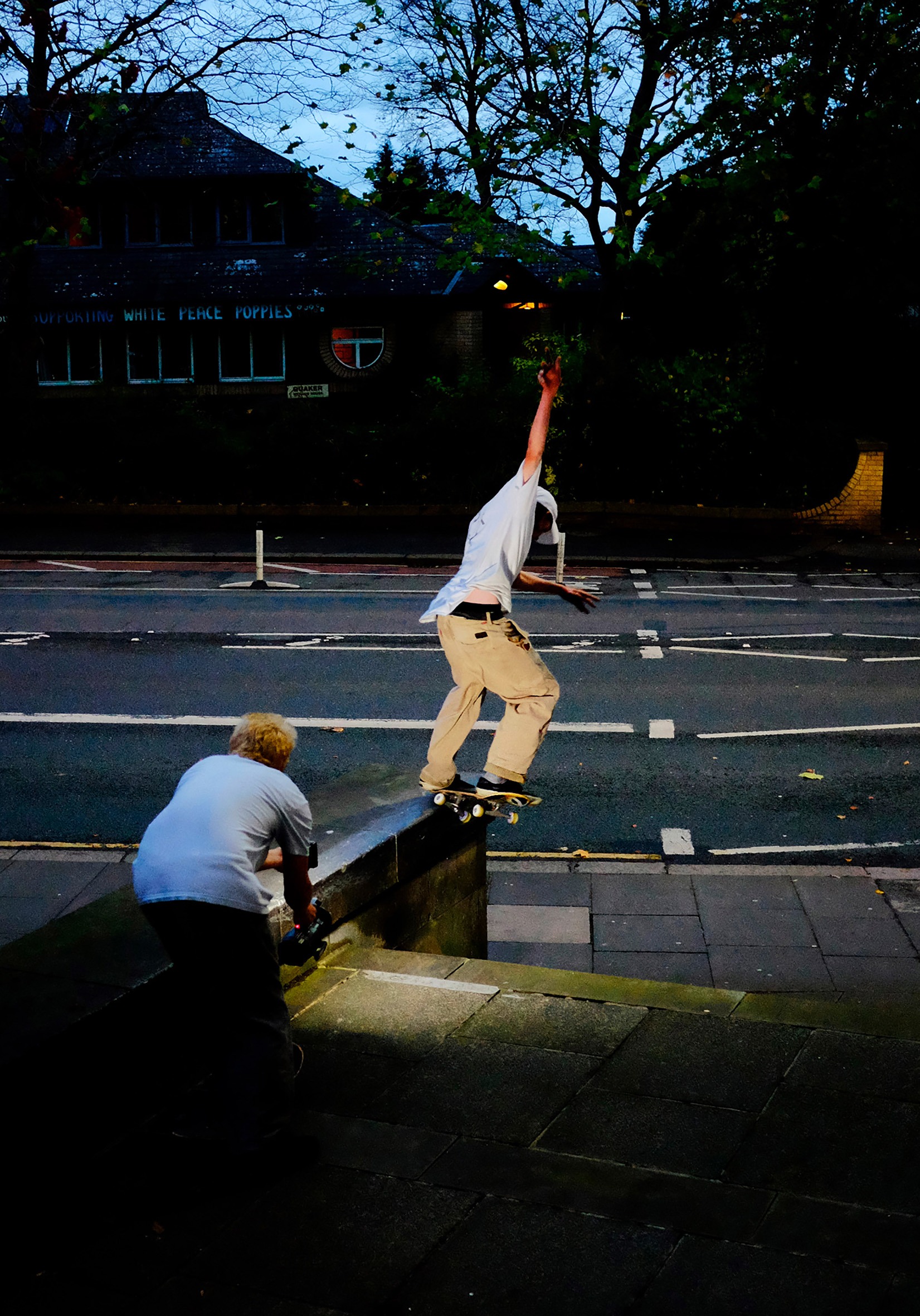
Naidan Glover – crook, Leeds. photo: Farran Golding
Naidan Glover and Logan Riley are two of the better known up-and-coming Leeds skaters right now. They’ve had footage in videos by Will Smith and Josh Hallett but TROUBLESHOOTING is their first video part. How set were you on making that happen?
I can’t remember when I became aware of Logan and Naidan but I was pretty keen for them to have a shared part from the get-go. It felt nice to have their first section together, everyone in Leeds associates them and are consistently blown away by how good they are. They think of things I wouldn’t ever have and I wasn’t dictating much of what they should try, which is sick for young skaters. I definitely didn’t have as solid of a trick selection or ideas for footage at 17 or 18. Then again, they’re really good at skating [laughs].
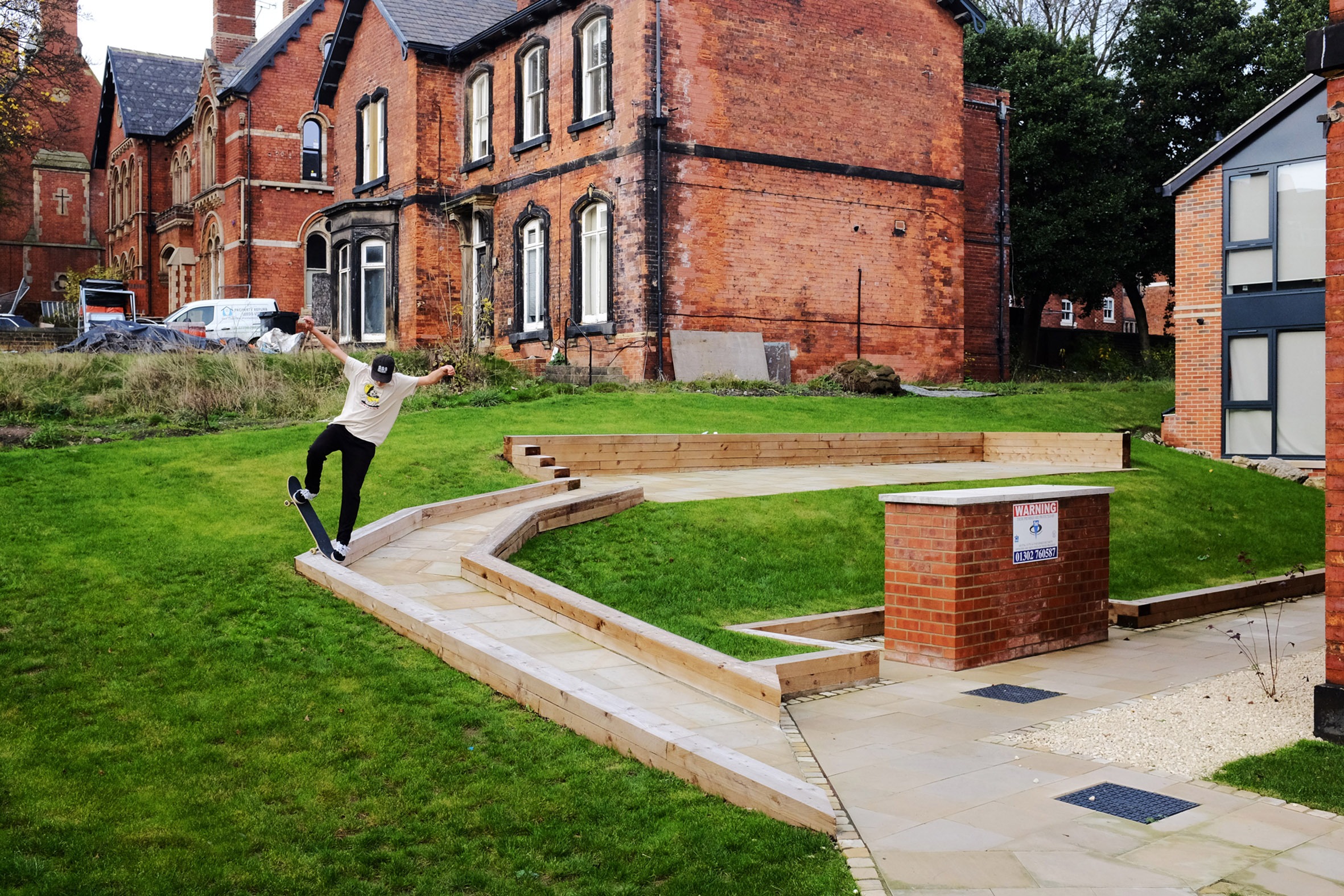
Logan Riley — bluntslide through both kinks, Leeds. photo: Farran Golding
Did you find yourself saying, “Don’t throw that on Instagram, it’s worth filming properly” much when you first started filming with them?
Because they’re younger, you can’t hold them to that mentality which is in some skaters’ psyche because they’ve grown up watching full-length videos and/or have filmed parts before. Logan and Naidan have come up with Instagram as the place to show what you can do so it would be harsh to say that. Like, what else are they going to do with it? They’ll do something harder next week anyway [laughs]. Also, filming for over a year with kids that talented, is it going to stand up or are they going to be hyped on it down the line? With anyone, a lot of the earlier footage ends up getting cut.
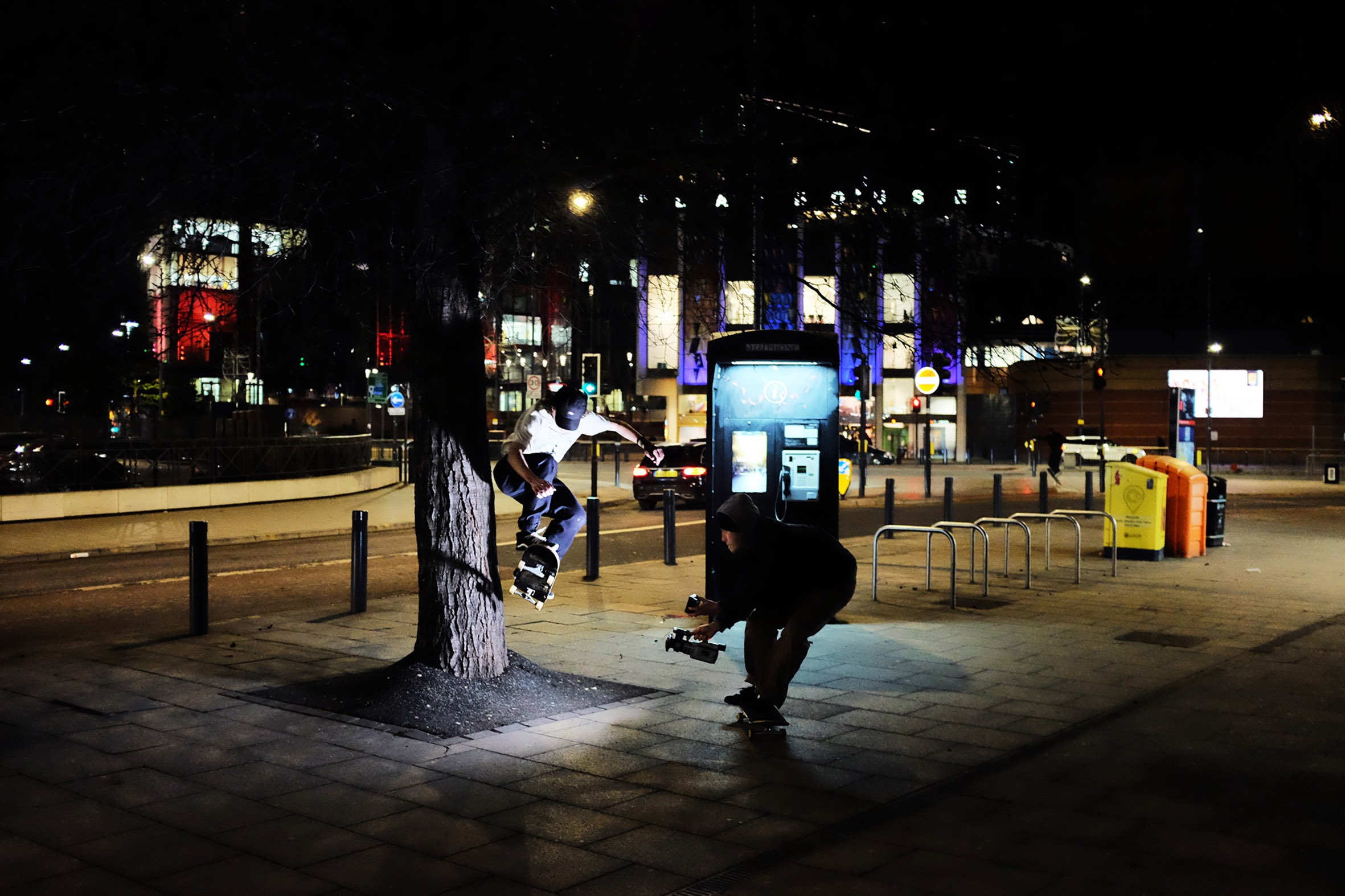
Leo Mercer, wallie, Leeds. photo: Farran Golding
Before Naidan and Logan, there’s a section featuring a bunch of other younger Leeds skaters like Leo Mercer, Olly Whitham, Ed Swiffen, Charlie Curle and Stan Watson. It was cool that you made them a prominent part of the video because, whilst Naidan and Logan ride for Welcome, the others aren’t as on the radar.
It wouldn’t have felt right to just have Naidan and Logan in there, it doesn’t make sense not to have their whole crew. Leo is really sound and has a unique interest in the skateboarding he likes and tricks for his age. Charlie has a cool style and can huck – they can all huck, they’ve got the knees for it [laughs].
If I imagine someone will be hyped having a clip in a video, that makes me hyped because maybe they haven’t had a clip in something with a premiere or a street clip filmed on a camera. That’s a nice thing to have, it keeps people skating, and makes them want to get into street skating and filming, which is a cool thing to engrain in the younger lot.
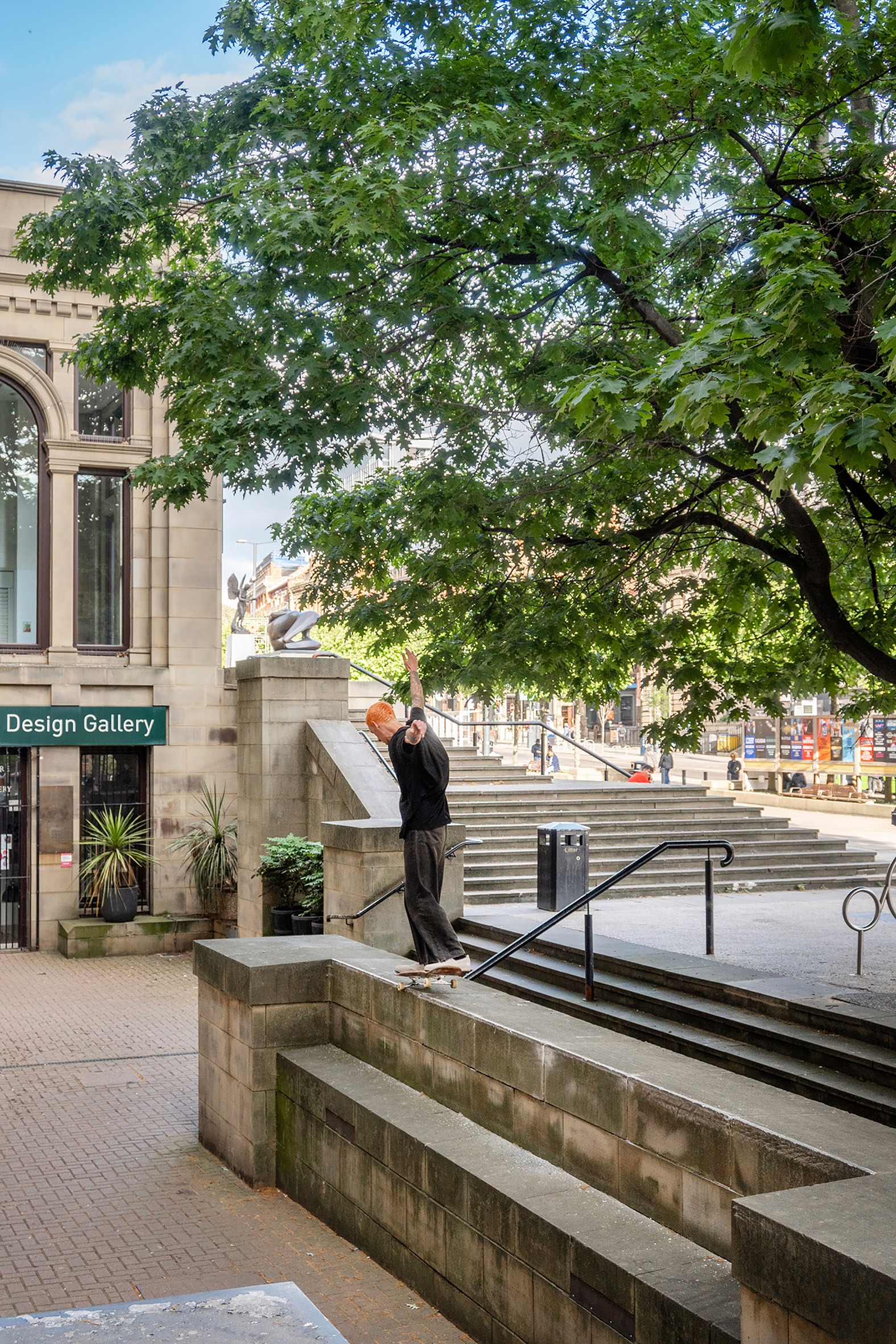
Chris Parsons — ride-on nosegrind, Leeds. photo: Farran Golding
Because of how the video flows, it’s surprising that you edit each section on separate timelines. Is that down to tech limitations and how do you decide who goes where when it comes to mastering the video?
I struggle with that the most. Because I’ve got the individual parts set up, if someone gets more footage later on then I have to move clips within timelines which is a little taxing. Originally, I worked that way because my old laptop I edited PÉTANQUE on just couldn’t cope as it was an hour long video. But part of it is naturally how I edit. It feels like a full-length in my head if it’s in “parts” but at the same time I want it to be interchangeable and not super linear, with people dipping in and out of sections if a moment is based on a spot or location. It started as a technical limitation but for a full-length, it’s how I like to be organised.
With that in mind, how do you approach some of the bridges between parts; say how the song playing over your ender carries into the younger friends section, for instance?
Easter egg; it’s not the same song, it’s two different songs by the same band [Algernon Cadwallader] but it flowed quite seamlessly. Daniel Dent does it and you have a realisation, maybe in looking up the soundtrack, that it’s two separate songs but how it transitions, if the music is used well and is a similar key and tempo, you’d think it’s the same. I like that idea and it’s probably ripped from Daniel Dent.
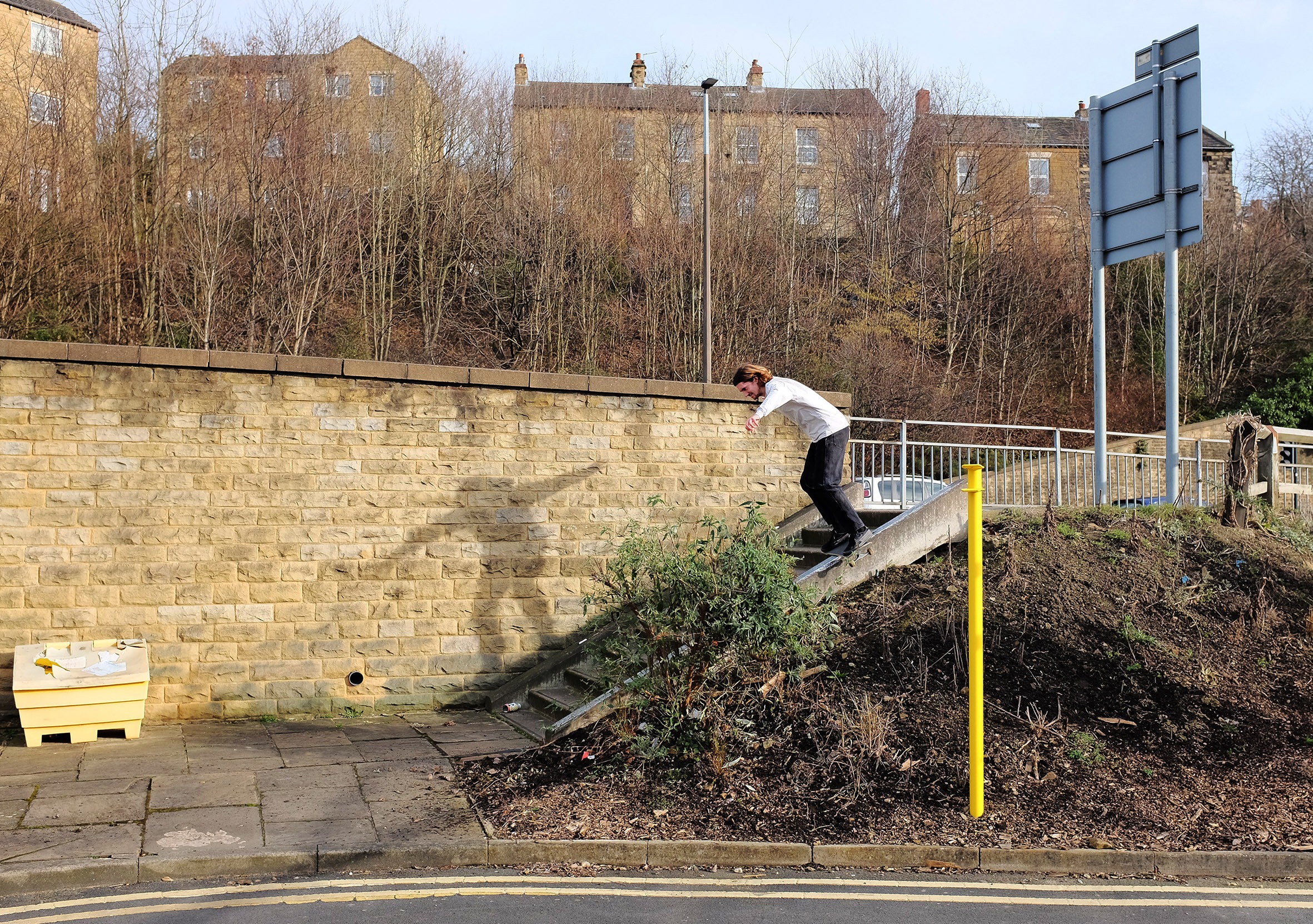
Harry Meadley, boardslide, Dewsbury. photo: Farran Golding
I remember you mentioning that a chapter from Kyle Beachy’s book, The Most Fun Thing, resonated with you regarding a specific aspect of part placement. Can you elaborate on that?
Putting Naidan and Logan before Harry was solidified after reading the chapter [“Making Up Legends In The Era of Zero Budget Skateboarding”] about St. Losers. Kyle Beachy writes about the last part not going to Randy Ploesser – who is really gnarly – but to Joe Herbert: this dude who has built and fixed up loads of spots in St Louis, where it’s filmed, including the spot he gets his last trick on, and he’s been in their scene for ages. There’s a parallel there with Harry, especially when it comes to Leeds-based skate media with him filming and a running local blog back in the day, even influencing Josh Hallett to start filming. Then there’s the age difference of an “older” dude who still gets footage so I thought that was a cool way of laying out a video – maybe a disclaimer is worthwhile here, Harry’s only 36. Aside from the peak of individual tricks, he has a lot of things that I can’t imagine anyone else in the video doing, from creative to gnarly, especially his last trick. There’s something to be said about having a last part, or even a last trick, which has a tone matching what you want from the video.
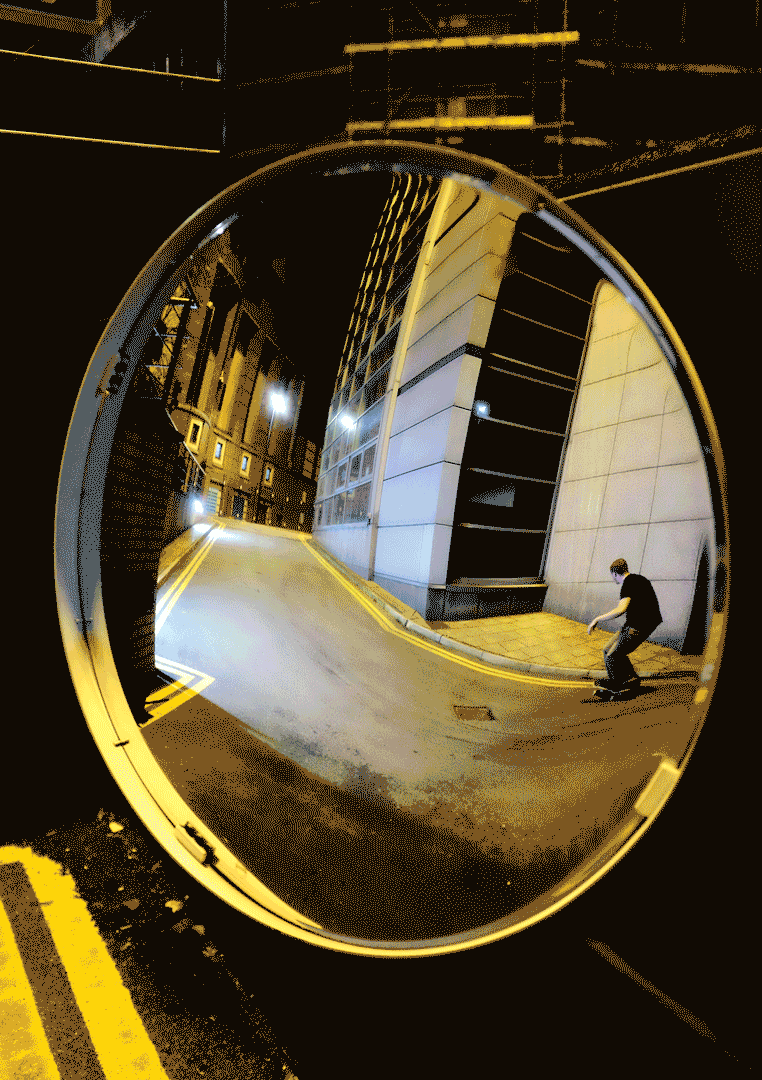
Joe Allen – manual up, shove, switch manual down. photo: Farran Golding
Before we move on from the subject of parts, early into this video you told me that you didn’t want to have a section. However, of course you ended up filming one and it’s great. If you’re into skating as much as you’re into filming skating, is that inevitable?
I suppose so. If I include myself as a skater, I’m on every session so I’m going to get footage. I like skating, I like thinking about spots, but I was in “filmer mode” more than the last video. I can’t remember feeling like I’d had a “proper part” prior to PÉTANQUE and during it, I was starting to figure out what I could do that was worthwhile to film. It felt like I was getting better at skating during that time. I didn’t want to put the pressure on myself with this one because towards the end of PÉTANQUE I broke my collarbone so anything with a bit of risk, I wasn’t so keen for. I didn’t do any “impact” tricks… Not that that was my forte before, I just want to do some manuals [laughs]. I’ve probably got a rival amount of my own footage, compared to anyone else, that I didn’t use but that’s how it should be. Curating everyone is part of a filmer’s job and anyone who cares about what they put out gets that so it’s never been a point of contention.
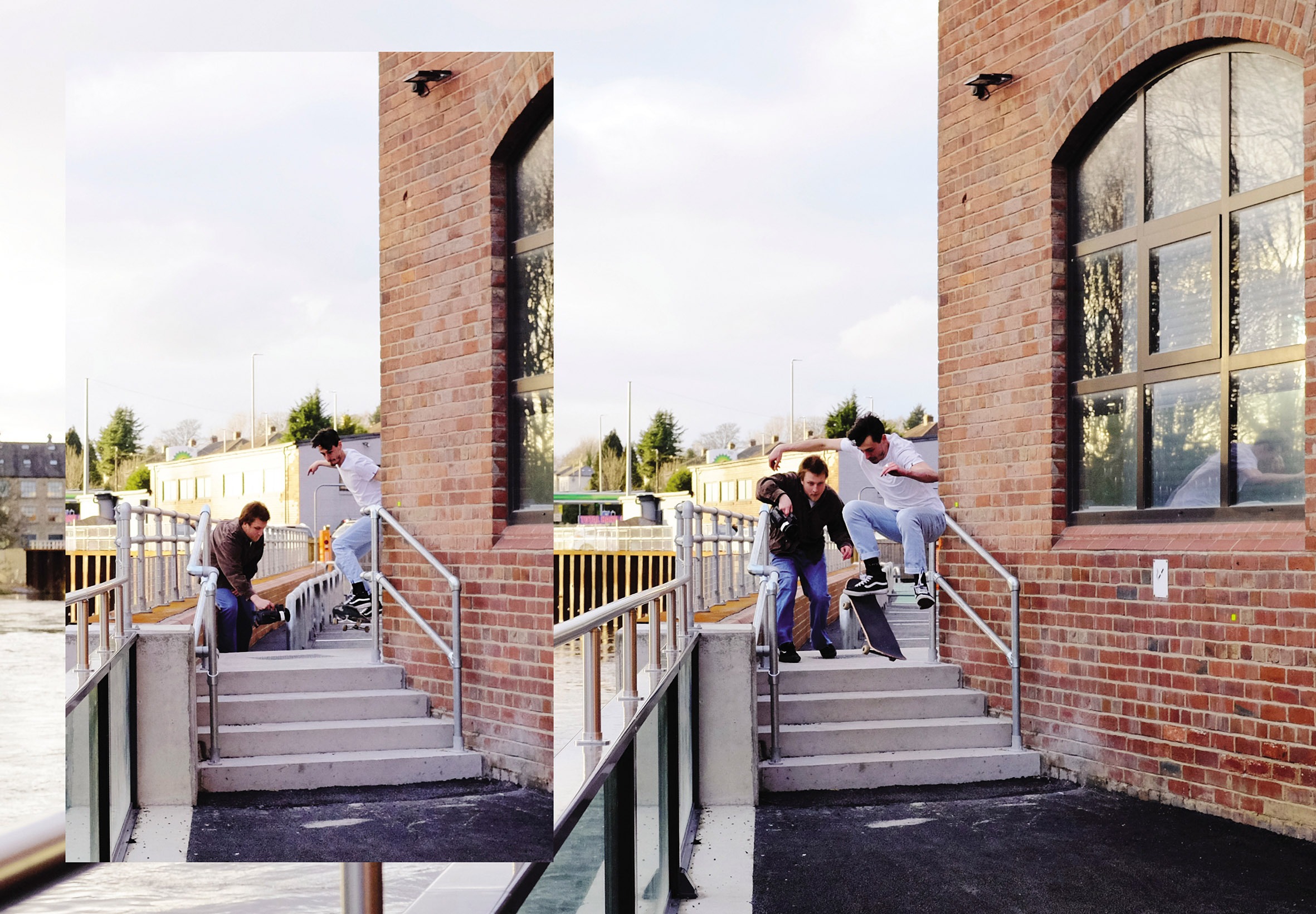
Farran Golding – ollie up and kickflip down, Leeds. photo: Al Lovell
Your last video, PÉTANQUE, feels very much like “a Leeds video” in the sense of framing the city itself, whereas I think TROUBLESHOOTING is more personal and creates a feeling for the people within it more so. Is that accurate?
It’s nice that you think they have different intentions and a different feel in how they come across because making two videos with some of the same people, back to back, that played on my mind: not having it feel like PÉTANQUE 2: The Sequel [laughs]. Which was hard because I didn’t have a solid theme, or aesthetic, other than filming the way I naturally do. I didn’t have a Super 8 camera for this so I didn’t film b-roll of buildings, stuff like that, which you very much want to do with a Super 8 in your hand. It was more just focused on the people, I guess. But not to give myself too much credit because, filming local videos, you’re literally filming with your mates and you’re not filming for any other reason than to make something together.
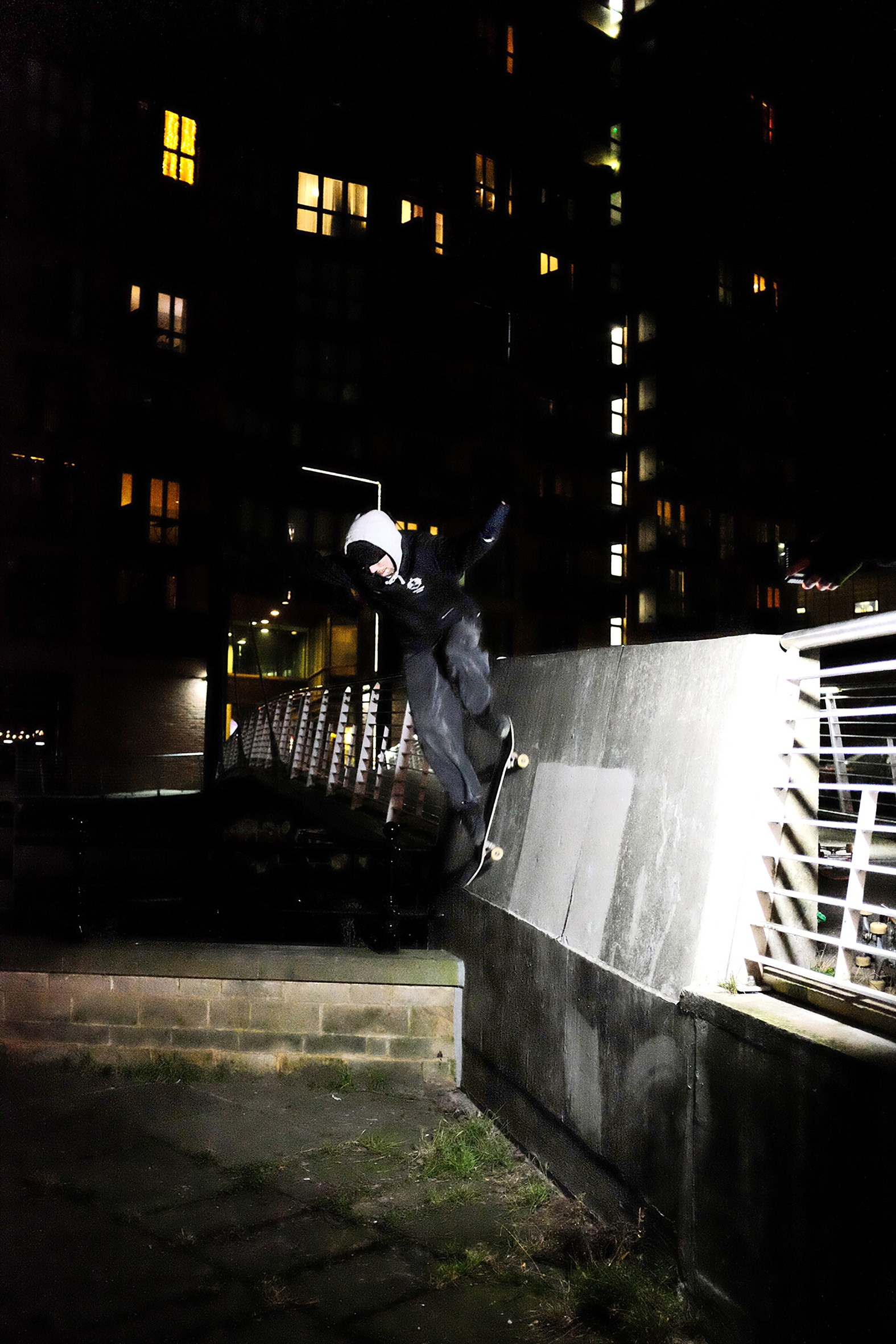
Paul Watson — drop-in, Leeds. photo: Farran Golding
It’s funny how the video’s aesthetic basically wrote itself, through your various camera issues but the name wasn’t picked until shortly before locking in a premiere. For what it’s worth, I think you pulled off the technical issues in a tasteful way and the video feels cohesive.
It was all edited way ahead of coming up with a name, it just worked out that the colour correction is reminiscent of a malfunctioning, older camera as sometimes they go a little bit red, green, and have a weird contrast. I thought nothing more of it than it would be cool to use those colours, I liked how it looked, and the song for the intro is called “Green Typewriters” so I used a typewriter-esque typeface.
I thought it was a pretty loose name and I figured it would just look like “a skate video” but at the premiere, people noted the style of footage and occasional glitches. A couple of people even asked if it was done in-camera and that surprised me. I guess people “got it” in the best way possible and thought it was more intentional than it was. Originally, I would have wanted to do just a VX video but camera issues necessitated otherwise. I’m glad you say it doesn’t look all over the place. Overall, I was just trying to film a skate video with a camera that worked [laughs].
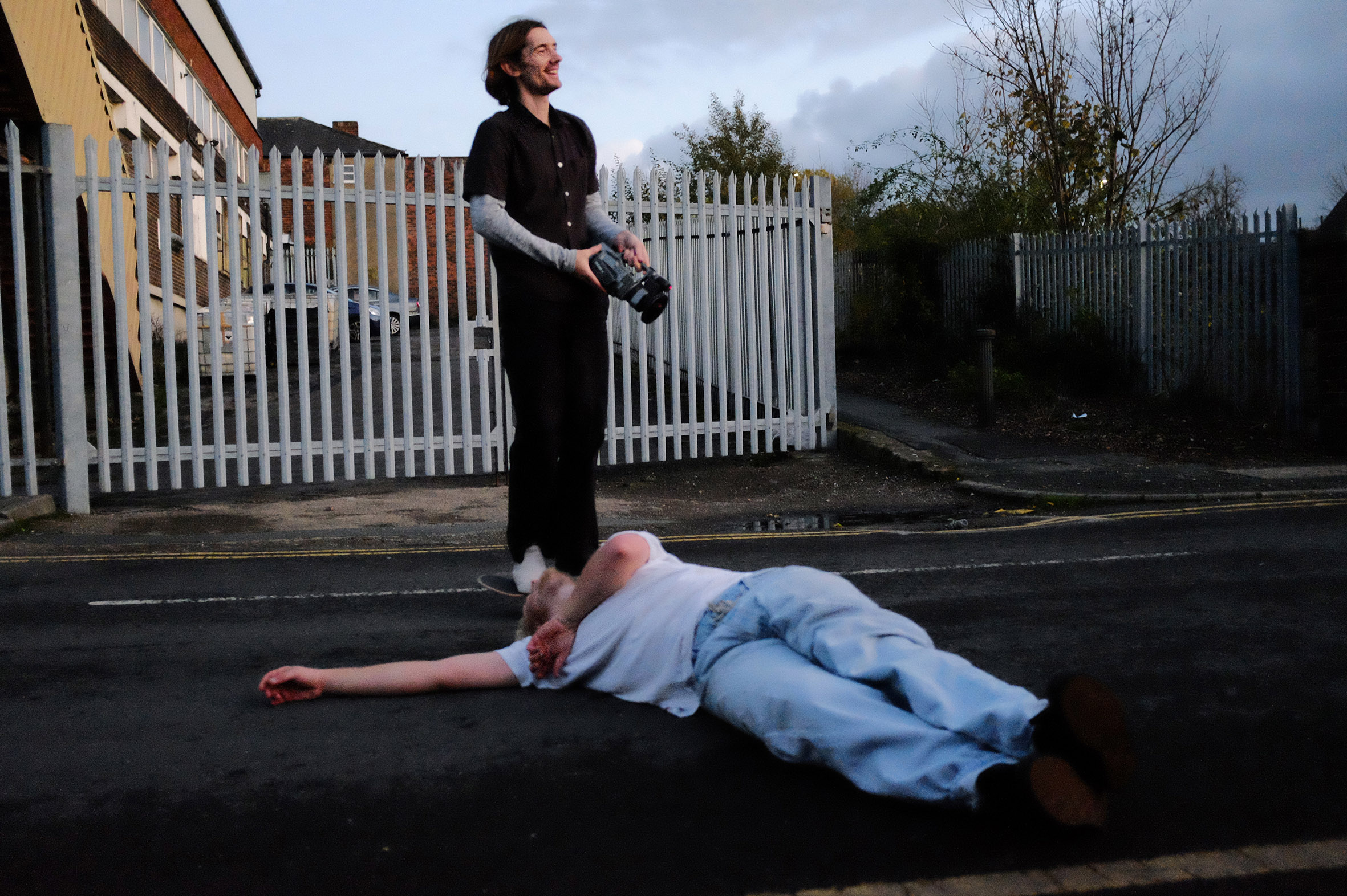
Harry Meadley & Joe Allen, Leeds. photo: Farran Golding
Do you still feel attached to using a VX, or tape-based cameras in general, after TROUBLESHOOTING?
After this, I couldn’t give a fuck about DV tapes or certain cameras [laughs]. It’s getting to the point, probably for a lot of people where it’s, like, is it really worth it? Yeah, it looks sick but a lot of what comes out of a skate video is what that specific person puts into it, rather than what they use to film it. TROUBLESHOOTING was something of a realisation for me: it could be a worse camera, it could be a better camera, it’s how you use it and edit the footage that makes something memorable.
Filmed + Edited by: Joe Allen
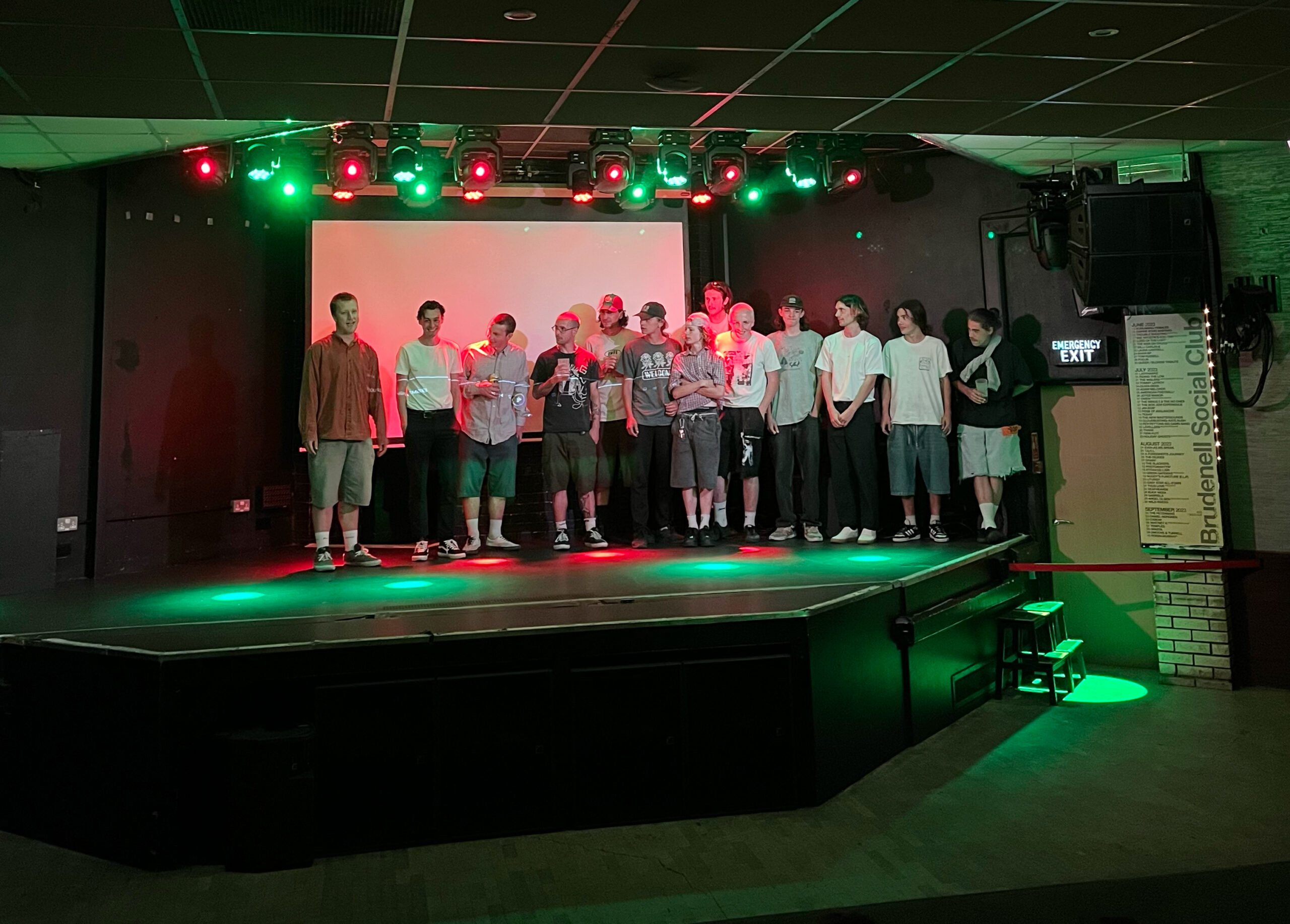
TROUBLESHOOTING crew and supporting cast at the premiere, from left to right: Joe Allen, Farran Golding, Tom Davies, Jono Coote, James Kelly, Logan Riley, Stan Watson, Ed Swiffen, Olly Whitham, Naidan Glover, Harry Meadley, Fred Ryan, Paul Watson. photo: Ruby Penson
‘PIECE TO CAMERA’, a zine documenting the filming of TROUBLESHOOTING by Farran Golding is available from Welcome Skate Store, The Palomino Club, Division 24 Skate Store, Cardiff Skateboard Club, Village Books and in the U.S.A. via Theories Of Atlantis.


